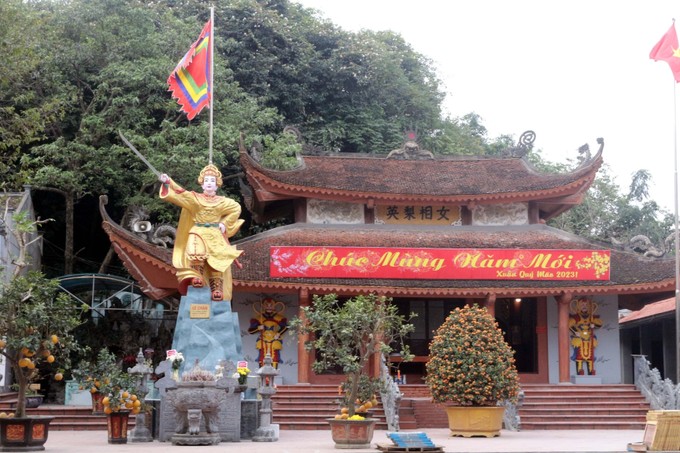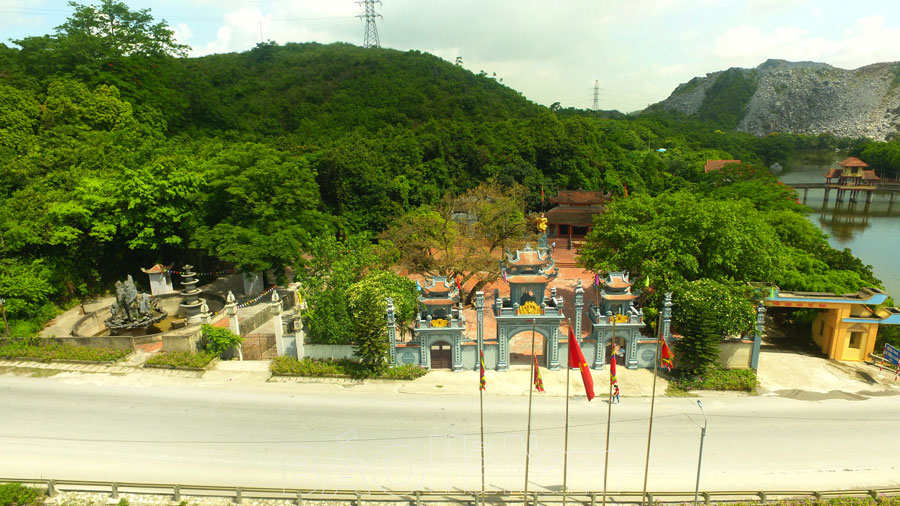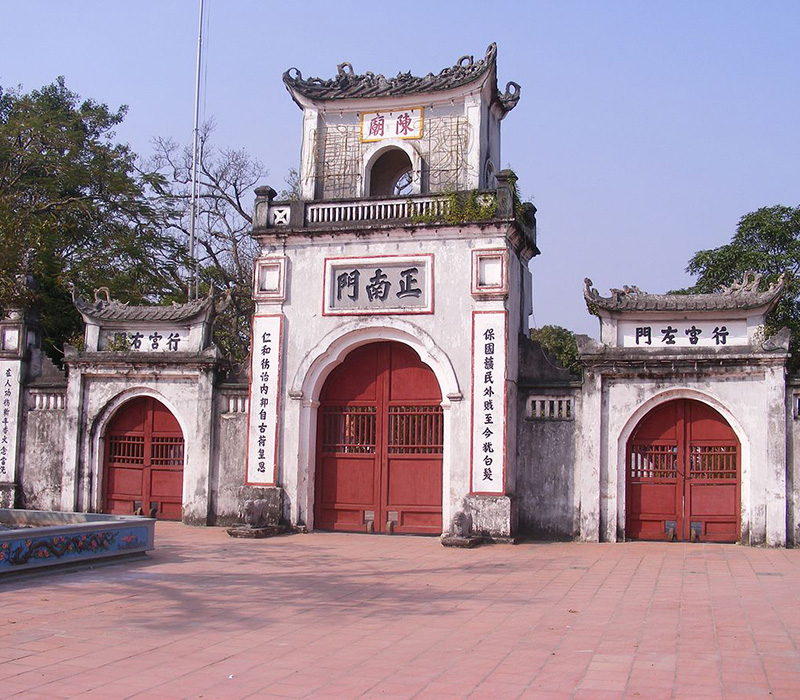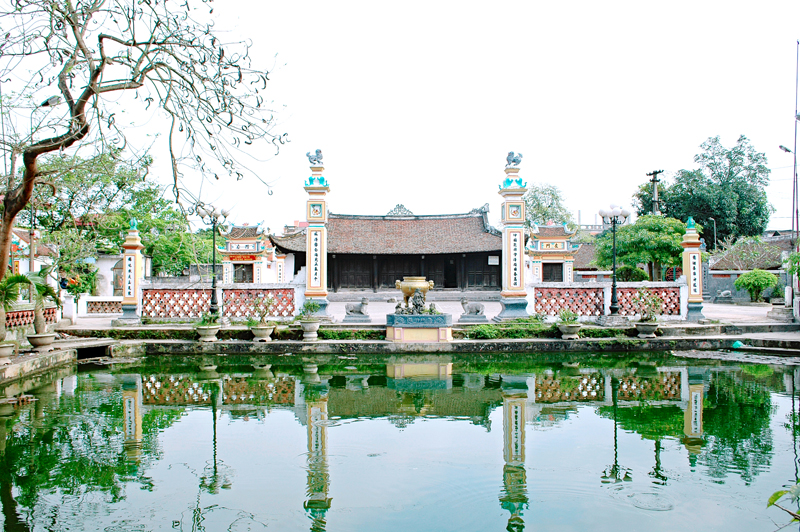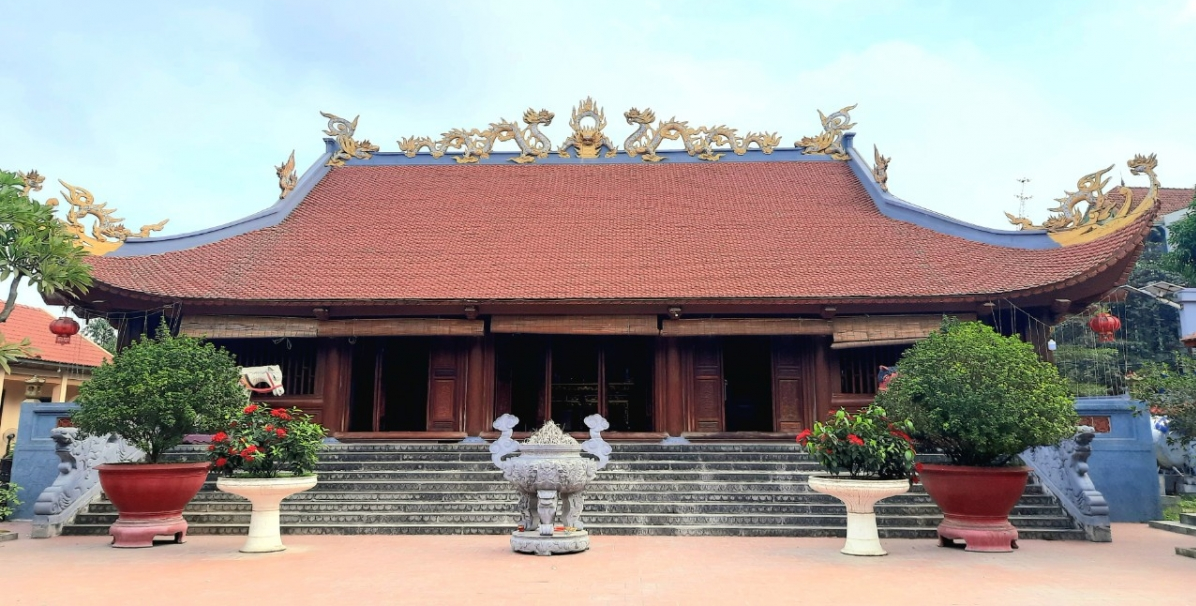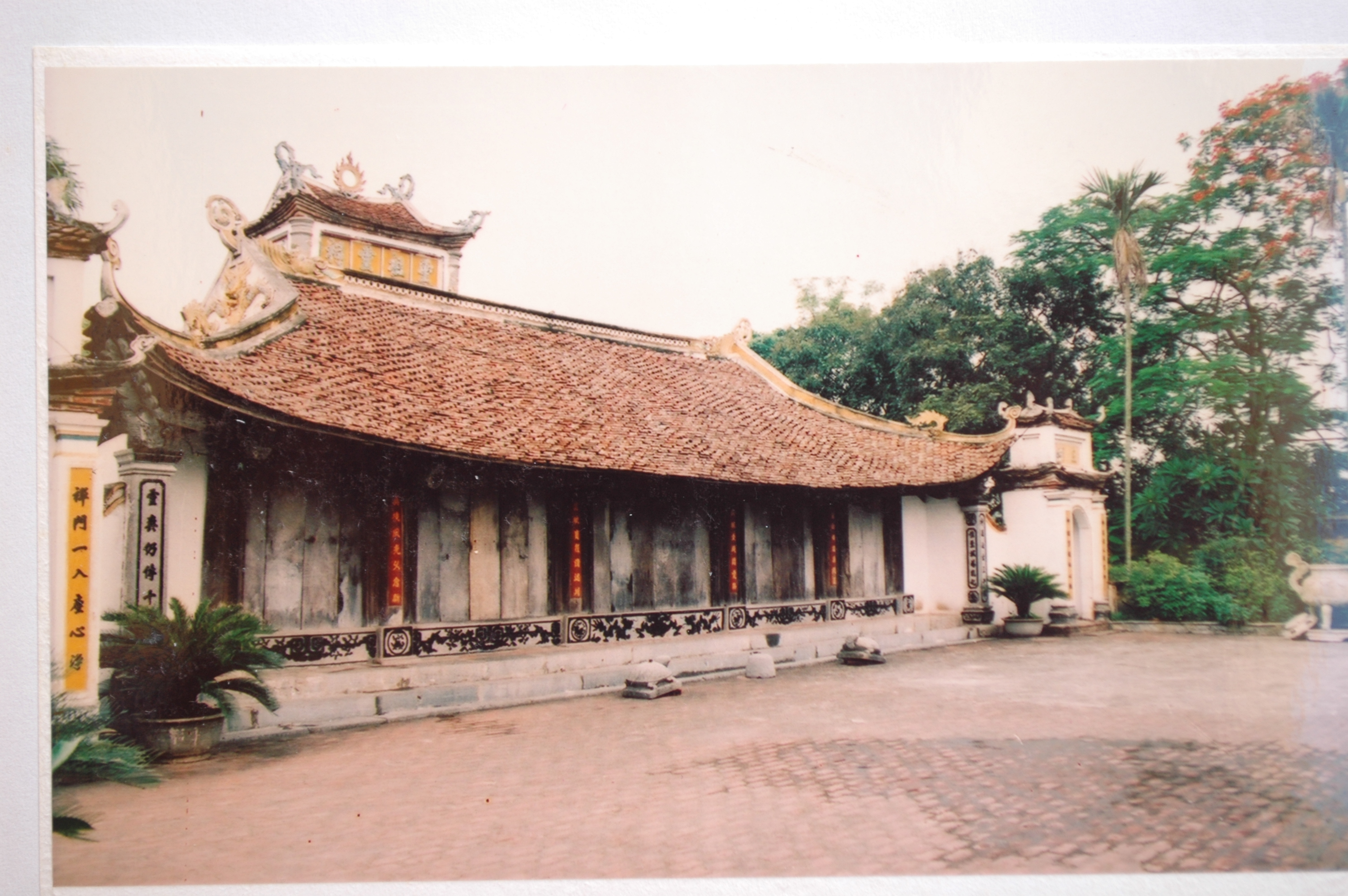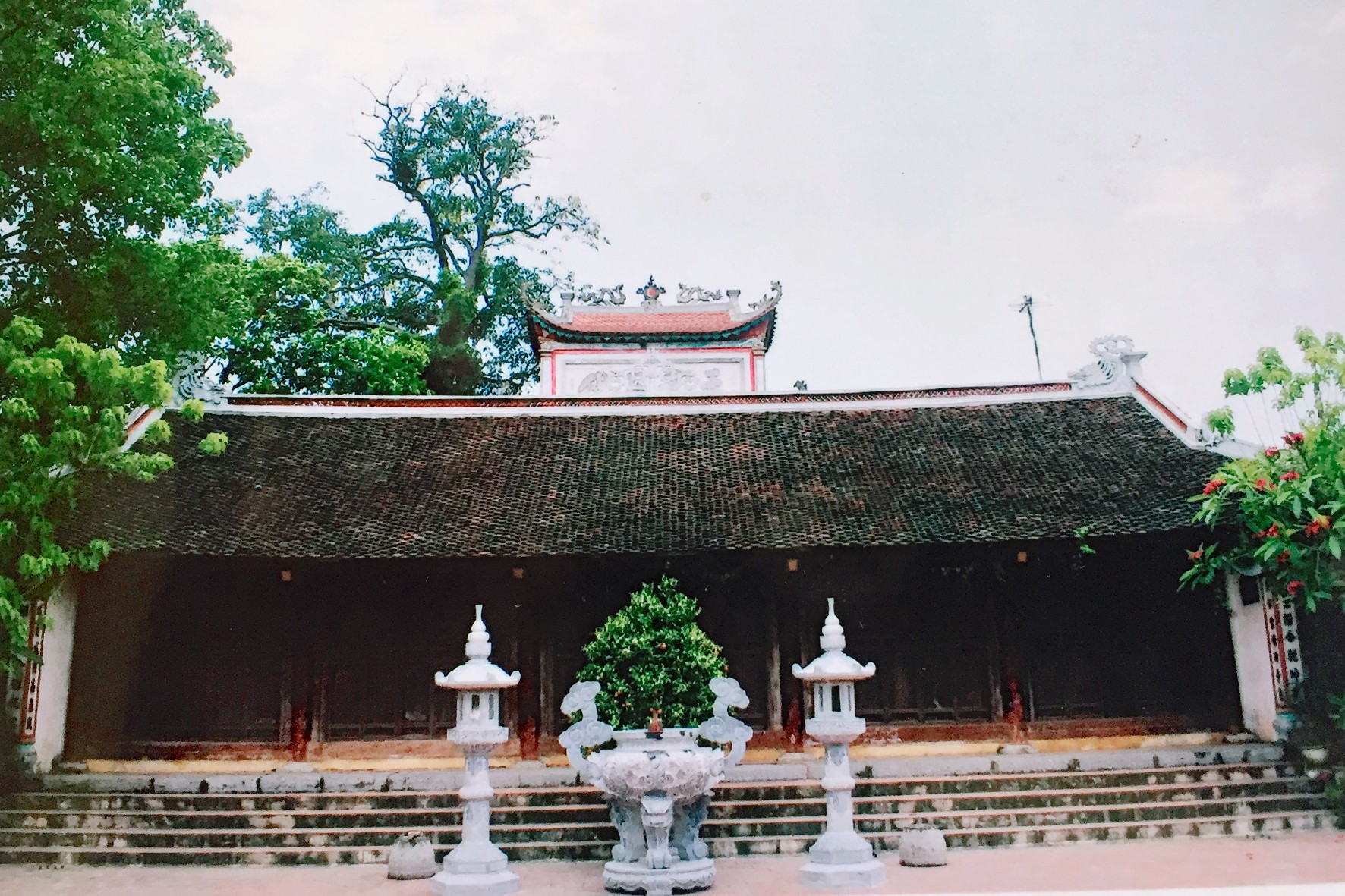Relic point Vietnam
Việt NamDinh Trieu Hoi
Trieu Hoi communal house in Bo De commune, Binh Luc district, Ha Nam province is a place to worship two village tutelary gods. One was Cao Mang, a talented general of the Tran Dynasty, and the other was Tran Xuan Vinh, who passed the second doctoral degree and became a mandarin under the reign of King Le Thanh Tong, in the reign of Hong Duc. The genealogies of the two gods are now lost, but the villagers still tell the strange story about the doctor of Le Dynasty Tran Xuan Vinh. Legend has it that, after passing his doctorate, on the way back to visit his hometown by Chau River, his and his parents' boats capsized, the whole family drowned, and his body floated to Bai Nhot. People built a small temple to worship him. The temple is very sacred, so the villagers asked for incense sticks to build a temple to worship him as the tutelary god. Thus, according to legend and logical reasoning, the god Cao Mang of the Tran dynasty must have been worshiped before, and after having a temple to worship the doctor of the Le dynasty, a communal house was established to concubine these two gods. Trieu Hoi Communal House is built in a three-compartment style: the front hall has five rooms, the second palace has five rooms, and the main palace has three rooms. The communal house has been renovated many times and on the upper salary, there is a record of one renovation in the sixth Thieu Tri era. The front hall has five compartments, roofed with male tiles, and the roof is covered with two dragons flanking the moon. The communal house's door frame is made of ironwood. The floor is paved with silk thread tiles, true to the ancient style of Vietnamese communal houses. The door set is made in the style of a table, with sliding bars on top and bottom. The second palace was repaired many times, the carvings remaining only on the first verses, 4-line armpit beams with simple stylized motifs. The three main rooms are designed with ironwood like the front hall, although the carvings here are not as elaborate. Trieu Hoi Communal House is classified as a historical relic because it was here that a demonstration march to demonstrate the prestige of farmers in the area took place on October 20, 1930. This march aimed to mobilize the masses to fight for the abolition of the Cai Luong council, for a reduction in tax collection, to support the Nghe Tinh Soviet and the struggle of farmers in Tien Hai and Thai Binh. Bo De commune was chosen as the location of that protest because the Ha Nam Provincial Party Committee determined that not only was the movement stable, but it was also adjacent to three districts of Binh Luc, Ly Nhan, and My Loc, so it could focus on promoting prestige. The time of the protest was set for October 20 because that was the main session of 3 markets: Bo De, Thanh Thi and An Ninh. At exactly 7 a.m., the drums at the Trieu Hoi communal house rang out, the red hammer and sickle flag flew, and protesters posing as market goers began to stand in line. Under the direction of the Ha Nam Provincial Party Committee and Binh Luc District Party Committee, the protest group went to designated locations such as Diem Tong, Don market (An Ninh), Ba Hang (Thanh Thi), speaking and broadcasting while walking. A petition calling on people to rise up and fight against feudalism, against terrorist attacks, and to support the Nghe Tinh Soviet Union. The protest group is increasingly crowded, starting from Bo De market with 300 people and reaching Vac market (An Ninh) to thousands of people. Faced with the overwhelming revolutionary spirit of the protest, the landowners, tycoons, and lackeys of the French colonialists were very frightened. At 12 noon, the leaders decided to hold a rally at Voc market and then disperse. The demonstration was a complete victory. The victory of the protest is an important political victory, having a great influence on the political struggle movement in the province and the whole country. This event was taken by leader Nguyen Ai Quoc as a proof of the spirit and revolutionary ability of Vietnamese farmers in his report to the International Farmers on November 5, 1931. Source: Ha Nam Province Electronic Information Portal
Ninh Binh 3983 view
Temple to worship female general Le Chan
According to historical records, Female General Le Chan was born on February 8, 20 early AD. She was born in the coastal region of Quang Ninh; established a hamlet and trained soldiers in the coastal city of Hai Phong, but committed suicide in the mountainous region of Lat Son (now Hong Son village, Kim Bang, Ha Nam). Bearing a grudge against the family, owing money to the country, and listening to Queen Trung's message to save the country, Le Chan brought insurgent troops to follow Hai Ba Trung and set up an uprising flag to expel the Han invaders. Giat Dau Mountain is the highest mountain in the Lat Son region, where on July 13, 43, when unable to defeat the Han enemy, the female general committed suicide and threw herself from the top of the mountain into the valley. People in the area commemorated her by setting up an altar at the foot of the mountain and building a pagoda and temple to worship her. This place still has traces in the Lat Son forest. Le Chan Temple is currently located on Le Chan Street, Hong Son village, the main hall faces south. In front of the temple gate in the past was the Ngan River - a tributary of the Day River, behind the temple was Ong Tuong Hill. The overall architecture of the temple area includes: Main temple, shadow, Son Trang cave, guest house and auxiliary works forming a closed complex with an area of over 4,000m2. On the yard, in front of the temple door, the statue of a female general stands majestically, drawing her sword and facing the old base. The statue was built before the temple was rebuilt (in 2006) and was modeled after the statue of a female general in Thuy An temple (Quang Ninh), her birthplace. The biggest festival taking place at the temple is on the 13th day of the 7th lunar month every year (the day of female transformation). People will organize a festival to commemorate the merits of the female general, and at the same time pray for people to go to the forest and farm smoothly... From July 11, the villagers began preparing to hold the announcement ceremony at the temple, asking for permission to open the festival. During festivals, the temple welcomes many groups of visitors from inside and outside the province to the temple to worship. The main festival day is July 13. Early in the morning, villagers and tourists gathered at the temple to carry out the palanquin procession into the village communal house. Source: Ha Nam Electronic Newspaper
Ninh Binh 4338 view
Historical Relic of Lat Son Base
Lat Son base - where Female General Le Chan established a base and died during the uprising of Hai Ba Trung in the Spring of Canh Ty in the year 40 (AD). This was the first uprising of the Au Lac people against the Northern Eastern Han feudal force. The uprising won, Trung Trac proclaimed himself king, named Le Chan "Princess Thanh Chan" and assigned the task: "In charge of internal military authority" stationed at the center of Giao Chi to guard the East Sea. North of our country). Some time later, the Eastern Han Dynasty sent Ma Vien to return with troops to invade us. The Hai Ba Trung uprising failed. Le Chan secretly sent his army to operate in the Hai Phong area (Kien An). ) - Hai Duong - Thai Binh - Ha Nam today. When the war against the Eastern Han invaders fell into a dangerous situation, Female General Le Chan continued to sail with her navy to the south of the Red River Delta and chose the rugged mountainous area of La Son (Kim Bang, Ha Nam) as a base. Keep defending to block the Eastern Han army. The reason Le Chan chose Lat Son as his base is because this place has a dangerous location, its back leans against the bow-shaped mountain range in the West running from North to South; In front, to the East are the Day River and the Ngan River like two moats. The terrain of the base can be attacked when advancing, retreating can be held, and the ends can respond to each other. The defensive battle was built in the valleys in front of the mountain, in caves and rocky hills stretching about 7 km from North to South. The head of the base is in the North, placing an outpost in Moc Bai valley, where the vanguard army is arranged to block the first attack of the enemy... behind Moc Bai is Doc Voi Truot hill where the soldiers are arranged. . Next to the South, Hoc Bac valley has food warehouses and logistics; Be valley (also known as Mo valley), Dau valley where the army is stationed. Diem Cave on the southern slopes of Be Valley is where the headquarters is located. To the west of Dau Valley is Thuoi Mountain (about 225m high), where the watchtower is located, observing the entire base. Near Thuoi Mountain, there is Troop Point Hill, probably a gathering place to count the number of soldiers. Behind Thung Dau are two valleys, Doi Nhat and Doi Nhi, where the two armies are stationed, and Dong Loan valley near Giat Dau, where the fiercest battle took place between the insurgents and the invaders. Ong Tuong Hill, the starting point of the base, is not far from the Ngan River to the west. Some places in the base area such as Don hill, Non Tien, Thung Cha valley, especially Egg Lake, which is several dozen acres wide. When Ma Vien sent troops to besiege and launch many attacks. Female general Le Chan organized resistance both in the valleys and on the Ngan River. Fierce battles took place, our troops fought tenaciously. The enemy quickly destroyed the Moc Bai outpost, poured into Hien valley and Be valley, and drove the insurgents to Dong Go. The final fierce battle took place in Dong Loan valley. Due to not having enough force to defeat the enemy, female general Le Chan and her confidant retreated to Giat Dau mountain. From the top of a high mountain, on a steep slope, Female General Le Chan committed suicide to avoid falling into the hands of the enemy. The confidant General buried Female General Le Chan in a cave in the Lat Son base. Later, to engrave and commemorate the great contributions of Female General Le Chan, Thanh Son people respectfully honored her with the noble title: "Holy Mother", and also sculpted a statue and built a temple in forest gate, on Ong Tuong hill. Nearly 2,000 years have passed, but the land names, mountain names, river names, relics, and relics that exist here are still there, reminding today's generations of historical places associated with the tradition of building the country and protect the country of the nation. With the historical and cultural values mentioned above, the Lat Son base area (with 3 typical locations: Le Chan Temple, Thanh Chan Cave, Giat Dau Mountain) - is both a place that marks historical events. , both a place of worship and honoring the contributions of Female General Le Chan to this land, has been ranked a national monument in 2023 by the Ministry of Culture, Sports and Tourism. Source: Ha Nam Electronic Newspaper
Ninh Binh 4482 view
Nam Dinh flagpole
Nam Dinh flagpole is located on To Hieu street, Ngo Quyen ward - Nam Dinh city. In ancient times, Nam Dinh flagpole was also called flagpole. This is one of four flagpoles built in the early Nguyen Dynasty. Nam Dinh flagpole was ranked as a national historical relic on April 28, 1962. The Nam Dinh flagpole today consists of three main parts: the base (pedestal), the body (long body) and the lookout (gazebo). Nam Dinh flagpole is 23.84m high; Located south of the Citadel, about 100m from Vong Cung communal house (now Vong Cung pagoda). The old flagpole yard was built into a ceremony yard, square in shape, with railings on four sides. To the south are placed two cannons. In the east, there is an incense burner commemorating the martyrs who sacrificed their lives in two resistance wars against the French to protect the Flagpole - the Citadel in 1873 and 1883. The base of the flagpole consists of two square bases. The upper platform is smaller than the lower platform. Around the outside of both sides of the pedestal, railings are built. From the lower platform to the upper platform, there are steps up and down. The four sides of the pedestal have railings and four doors. On the second pedestal, there is a door leading into the body of the flagpole (stand body). On the east door are the two words Nghenh Huc (welcoming the morning light); The southern door has two words: Huong Quang (directing according to the virtue of light). Below the pedestal is the Temple of the Flagpole Princess - Princess Nguyen Thi Trinh - the first martyr, who died in the battle of the French invaders to capture Nam Dinh citadel on December 11, 1873 (archaeological discovery in 2002). – Vietnam Institute of Archeology – Le Ba Ngoc). The flagpole's body is 12.65m high and gradually shrinks towards the top with two parts: The lower part is built in an octagonal cylinder, the upper part is built in a circle with a base diameter of 3.25m. In the flagpole's body, there is a spiral staircase, including 54 steps going up to the lookout, illuminated by 32 rosette-shaped windows on the eight sides of the flagpole's body. The lookout part is built in a cylindrical shape with a railing, 4 arched doors and 8 small windows. From the lookout side, there is a small iron ladder to the top of the flagpole. The flagpole is built of old burnt bricks, dark red in color. The square corners of the two pedestal floors are built of a type of brick that specializes in a 450 beveled end, while the 1200 corners of the octagonal pillar body are a separate type of brick. Thanh Nam flagpole is associated with many important historical markers. On March 27, 1883, French warships from the Dao River bombarded the Citadel. At the flagpole, at a height of 11m, to the south, there is a bullet hole 4cm deep and 6cm in diameter. During the period of secret activities, many officials and Party members still used the Flagpole as a place of communication and activities to discuss plans to direct the movement. In 1967, Nam Dinh was fiercely attacked by American aircraft. The top of the flagpole is where the aircraft observation team led by comrade La Vinh Hao - self-defense of the Textile factory is on remote mission. On June 11, 1972, American planes rushed to attack the city of Textile. At 10:10 a.m., they fired rockets and bombs, hitting the Flagpole area, causing the entire ancient structure to collapse. In 1997, commemorating the 43rd anniversary of the liberation of Nam Dinh city, the flagpole was restored to its original form. For nearly two centuries, Thanh Nam flagpole has witnessed many historical events and changes in the country and homeland. This is an ancient architectural work with historical and cultural value and is also a symbol that arouses love for one's homeland, a sense of pride, and an iron determination to protect sovereignty, independence, and freedom. due to the Vietnamese Fatherland. Every year, this place welcomes hundreds of domestic and international delegations to visit and burn incense to commemorate the Flagpole Queen. In 1962, Nam Dinh Flagpole was recognized by the Ministry of Culture and Information as a national historical-cultural relic. Source: Cultural and historical relics
Ninh Binh 4616 view
Tran Nam Dinh Temple
Nam Dinh Tran Temple relic area is a temple worshiping 14 Tran Dynasty kings, their families and mandarins with meritorious service. This place is also famous for the incense offering ceremony to open the Tran Temple seal in early spring and the Tran Temple Festival in the eighth lunar month every year. The Tran Temple - Nam Dinh relic area includes 3 main architectural works: Thien Truong Temple, Co Trach Temple and Trung Hoa Temple, with a common design and equal scale. In front there is a five-door gate. Through the gate is a rectangular lake. In the middle behind the lake is Thien Truong Temple. Thien Truong Temple, often called Thuong Temple, is located in the center of the Tran Nam Dinh Temple relic area. The temple was built on the foundation of Thai Mieu and Trung Quang Palace of the Tran Dynasty, which was formerly the family temple of the Tran family. Trung Quang Palace is where the Tran Dynasty emperors lived and worked. The current architecture of Thien Truong Temple includes the front hall, middle hall, main altar, incense burner, 2 rows on the left and right, 2 rows on the left and right of the morning glory tube, 2 rows on the left and right of the bamboo tube, 2 rows of the East and West. There are a total of 9 buildings and 31 rooms. The temple frame is built of ironwood, the roof is tiled, and the floor is tiled. The front hall is the place for worshiping and altars of mandarins who had great meritorious service in the Tran Dynasty. In the middle of the hall are the tablets of the 14 Tran Dynasty emperors. The main temple worships the four ancestors of the Tran family, and their wives and royal concubines. The incense burning court (sutra altar) houses the altar and tablets of the Tran Dynasty's officials. Co Trach Temple, often called Ha Temple, is located on the east side of the Tran Nam Dinh Temple relic site. In the front of the hall are tablets of three trusted generals of Tran Hung Dao, Pham Ngo, Pham Ngu Lao and Nguyen Che Nghia. The middle hall worships tablets and statues of Tran Hung Dao, his four sons, Pham Ngu Lao and other generals. The main altar placed the tablets of his parents, Tran Hung Dao and his wife (Princess Thien Thanh), 4 sons and 4 daughters-in-law, daughter and son-in-law. Burn incense (sutras) and place the dragon's temple, inside there is a statue of Tran Hung Dao and 9 Buddha statues. The space left the tablets of Truong Han Sieu, Pham Thien Nhan and Tran Dynasty officials. Thieves placed the tablets of the Tran dynasty's martial gods, Tran Cong and relatives of the Tran family. Trung Hoa Temple is located on the west side of the Tran Temple relic area. The temple was newly built in 2000, on the foundation of the ancient Trung Hoa Palace - where the Tran Dynasty emperors came to consult with the emperors. In Trung Hoa Temple, there are 14 bronze statues of 14 Tran Dynasty emperors placed in the middle hall and main palace. The incense burning court places thrones and tablets to worship the council of mandarins. Fraudulently worshiping civil servants. Fraudsters worship military mandarins. Every year, at the Tran Temple relic site in Nam Dinh, two major festivals will take place, which are the Tran Temple Opening Ceremony in early spring and the Tran Temple Festival in August, attracting a large number of local people and tourists from all over to attend. , grateful for the merits of the 14 Tran kings and praying for good things. Tran Temple is a special and important historical and cultural relic site of Nam Dinh province, ranked by the state as a national historical relic in 2012. Source: Nam Dinh City Electronic Information Portal
Ninh Binh 5825 view
Giap Ba Temple
Giap Ba Temple, also known as Cam Nang Temple, is located in Nam Giang town, Nam Dinh city. The project includes the main temple worshiping King Trieu Viet and two temples worshiping two generals of the Doan family. Since the Later Le Dynasty, this place was called Cam Nang village, Chau Nguyen commune, now Ba village, Nam Giang town, people still call it Giap Ba. The origin of the name Cam Nang temple or Giap Ba temple today is like that. Giap Ba Temple was ranked as a national historical-cultural relic in 1994. According to historical sources and legends, in Phat Noi commune, Chu Dien district, Tam Doi district, Son Tay religion, there was Mr. Trieu Tuc whose wife was Han Thi Sieu. One night, Mrs. Sieu dreamed of a flying dragon, and then she became pregnant. In the spring of the year Mau Thin, she gave birth to a handsome boy named Quang Phuc. As a child, Quang Phuc studied very hard and was proficient in literature and martial arts. At the age of seventeen, his parents passed away. He followed famous general Ly Bon to defeat the invaders of the Luong Dynasty and win independence for the country. In 544, Ly Bon ascended the throne, proclaimed himself Ly Nam De, and settled the capital in Long Bien. Not long after, the Luong Dynasty sent Tran Ba Tien and Duong San to invade our country; Ly Nam De lost the battle and fled to Khuat Lieu cave, handing over military power to Trieu Quang Phuc. In 547, Trieu Quang Phuc retreated to Da Trach swamp (now Khoai Chau region, Hung Yen), a large swamp area with luxuriant reeds; He ordered his army to set up a barracks on a mound in the middle of the lagoon, and used dugout boats to snipe every day, causing the Luong army to lose a lot of troops and become extremely confused. Gradually, our army won a great victory and wiped out the Liang army from the territory. After defeating the enemy in 548, Trieu Quang Phuc ascended the throne, calling himself Trieu Viet Vuong, with the capital in Long Bien. In 570, he was ambushed by Ly Phat Tu - who had the same surname as Ly Nam De - and had to retreat, then drowned at Dai Nha estuary on August 14. Legend has it that when fleeing, Trieu Viet Vuong stopped at Cam Nang village to set up a barracks but was still pursued and had to flee to Dai Nha seaport (now in Doc Bo village, Yen Nhan commune, Y Yen district). Currently, in Ba village, Nam Giang town, there are still vestiges of the time when Trieu Viet Vuong stopped, such as: An Ma Chien land - where the soldiers let their horses eat grass and drink water; The place where horses run is called Ma Khoi, in the southeast of the village there is Ma Run street, the old military barracks is Cua Cua area... After Trieu Viet Vuong passed away, to commemorate his great contributions, the people of Cam village Nang built a temple right on the land where he stopped. His temple is on a large scale, with many solemn and splendid sacrificial offerings. Through many feudal dynasties, Ba village temples were all ordained to serve. Right next to the temple of King Trieu Viet Vuong, there are two temples worshiping mandarins Doan Tuong Cong and Doan Cong Thuong. These are two people who lived in the 18th century, belonging to the Doan family in Cam Nang. During their lifetime, the two of them took on many important responsibilities at the Royal Court. Among them, Doan Cong Thuong, also known as Doan Cong Thuong, was promoted to the position of General Eunuch, in charge of the admiral of the Cong District under the reign of King Le Du Tong (1740-1786). To their homeland, the two men left behind many contributions. Therefore, the mausoleum as well as the temple of the two men are preserved, incense, and revered by the village people as the village's blessings. Source: Nam Truc District People's Committee
Ninh Binh 4679 view
Dai Bi Pagoda
Dai Bi Pagoda is located in Nam Giang town, Nam Truc district, Nam Dinh province. In addition to worshiping Buddha, the pagoda also worships Saint Tu Dao Hanh. Through Han Nom documents, it is said. Saint Zen Master Tu Dao Hanh's family name is Tu, his family name is Lo; His father was Tu, Huy Vinh... from Lang village, held the position of Tang Quan Do Sat. At a young age, there are many unusual things, he has an immortal spirit, is generous and generous, has great ambition, and no one can predict his actions or words. He became close friends with Confucian scholar Phi Sinh, Taoist Le Toan Nghia and the singer Vi At (some documents say Phi At). At night he diligently read books, during the day he played shuttlecock, played the flute, and gambled for fun. His father was killed by Dien Thanh's servant who asked Dai Dien to use magic. The Saint failed to take revenge. He found a way to Tay Truc to study magic. The road to Kim Xi country was difficult, so he returned to Phat Tich mountain to practice, read the Da La Ni mantra eighteen thousand times, and completed the Dharma. Find Dai Dien to take revenge. From then on, washing away the hatred, the monk went everywhere in the forest to find a teacher to confirm. Thanh met Zen Master Tri Huyen and Zen Master Sung Pham to learn and expand his knowledge. After that, the monk was reincarnated as the son of Sung Hien Marquis, later King Ly Than Tong. Dai Bi Pagoda is located on a large flat area of land with unique architecture. According to legend, the pagoda's land has the shape of a dragon's head. On both sides of the pagoda's door are two round wells that people here often call two dragon eyes. The architectural system of the pagoda has many unique features. Tam Quan (temple gate) is not located in the middle but was built slightly to the east. Although it has undergone many restorations, the Tam Quan gate still retains many carvings from the Later Le period (17th - 18th centuries). The temple is decorated with Buddha statues like any other Vietnamese temple. The difference in Dai Bi Pagoda is that on the right side of the Three Jewels, there is an altar to worship Patriarch Tu Dao Hanh and Zen Master Giac Hai, who have made many contributions to the country's Buddhism. In the field of Buddhism, Zen masters are considered holy monks; In the social field, they are considered village tutelary gods, people who have the merit of teaching vocational skills to the people... The statues at Dai Bi Pagoda are carved quite perfectly. In addition, there are many altar objects and couplets with historical and artistic value. Behind the pagoda there is a bell tower with match bell style architecture, 8 roofs with high, soft and elegant blades. This is the most valuable work of Dai Bi Pagoda. Behind the bell tower is the ancestral temple, which worships Bodhidharma, the 28th patriarch and master of the Zen sect. Dai Bi Pagoda also has a space to worship Mother Goddesses, a national belief that Vietnamese people have practiced for many generations. Dai Bi Pagoda also preserves many valuable relics, antiques, and ancient books, most notably 10 steles, of which the oldest stele was engraved in the year of the Goat (1679) during the reign of Le Hy Tong; 10 ordinations; The large bell is 2m high and was cast in the 18th year of Minh Mang's reign (1838). The belief of worshiping Saint Tu Dao Hanh on the land of Nam Truong, along with the unique architecture of Dai Bi Pagoda, hundred-room pagoda, purely Vietnamese, flourished in the 17th century and exists to this day, demonstrating the eternal vitality of the Vietnamese. With typical values of history, culture and artistic architecture, Dai Bi Pagoda was ranked as a National Monument in 1964. Source: Nam Truc District People's Committee
Ninh Binh 4659 view
Gin Temple
Gin Temple, Nam Duong commune, Nam Truc district, Nam Dinh province is a relic with typical historical and architectural and artistic value, and has been ranked at the National level by the Ministry of Culture since 1962. The temple is a place to worship and express gratitude to the local people for the holy Long Kieu - Kieu Cong Han, who helped Ngo Quyen defeat the Nam Han invaders on the Bach Dang River in 938. period of national autonomy. Later, when the Ngo dynasty collapsed, probably due to historical conditions at that time, General Kieu Cong Han became one of the 12 warlords in the context of the country's chaos and division. He soon died in the chaotic war between local sand forces. After General Kieu Cong Han passed away, to commemorate his contributions, local people built temples to worship him; Currently there are 72 temples worshiping generals, extending from Phong Chau, Bach Hac, Phu Tho province to Nam Dinh province, of which in Nam Truc district there are 2 temples worshiping generals: Gin temple, Chien village, Nam Duong commune and Tay Lac temple, Dong Son commune. During the period of fighting against the invading Song invaders, King Le Dai Hanh led his army through here. Staying overnight, the king dreamed that Kieu Cong Han promised to help the king fight the Song invaders. After defeating the invading Tong invaders, King Le Dai Hanh returned to grant him fields and was appointed Thanh Hoang. Later feudal dynasties provided sacrificial fields and repaired temples to engrave stone stele to record the work, as well as promulgate the title "Holy Long Kieu". Gin Temple's large-scale architectural work is arranged symmetrically and harmoniously, including items: temple wells, shrines, screens, ritual gates, external temples, front doors, internal temples and buildings. Central architecture (front street, forbidden palace), located on a campus of 3,290 m2. Gin Temple is a relic that still preserves almost all of the architectural and artistic style of the Later Le period, 17th-18th centuries, demonstrating the talented working hands and creative minds of folk artists. Artifacts preserved at the relic are extremely rich and diverse, especially antiquities of the Later Le and Nguyen dynasties such as: miracles, ordinations, incense tables, thrones and tablets, worship statues, stone sculptures, etc. .. The decorative art at Gin Temple is very rich and lively with sharp carved lines and diverse decorative themes, combined with carved styles such as: pine wind, bong canal, contributing to the theme. making the decorative themes at the monument more vivid and imbued with traditional national style. Shown through architectural items such as Tien Cac, Tien Duong, and Forbidden Palace. Themes (Dragon, Ly, Quy, Phuong), turning leaves, patterns of seals and leaves, phoenix flanking; Dragons rolling water, two dragons flanking the moon and dragon-shaped apricot patterns... are decorated on the architectural components of Gin temple, crafted by ancient artisans with a tight layout and rich themes. , vividly contribute to honoring and affirming the architectural and artistic value of the monument. Gin Temple Traditional Festival is one of 10 typical festivals of the entire Nam Dinh province. The festival takes place on the 8th, 9th, and 10th days of the December month (lunar calendar) every year with unique rituals and folk cultural activities such as palanquin procession, water procession, cheo singing, tom whore nest, cockfighting ... Source: Nam Truc District People's Committee
Ninh Binh 4112 view
Am Temple
Am Temple is located in Nhat village, Nam Giang town, Nam Truc district, Nam Dinh province. Am Temple is where local people worship and pay tribute to the merits of the Holy Patriarch, Zen Master Bui Hue To (1566 - 1641). The belief in worshiping the Holy Patriarch Bui Hue To at Am Temple, in addition to the meaning of worshiping a true monk and a blessed god, also has another meaning, because this is his hometown. After the Holy Patriarch "transformed Buddha into fire", to remember his merits, local people built a temple to worship. The temple was built right on the hermitage ground that the Holy Patriarch had previously created. Although many centuries have passed, the worship of the people in Nam Truc countryside in general, and Nhat village in particular, towards the Holy Patriarch has remained unchanged. That demonstrated the gratitude and deep respect of the people for his merits, a lifelong true practitioner for the sake of the nation's Dharma, for the peaceful and prosperous life of the people. With typical values of history, architecture and art, on December 14, 2012, the Ministry of Culture, Sports and Tourism recognized Am Temple as a national historical architectural monument. Am Temple is located on a land area of 2,685 square meters, facing southwest. Around the temple there are many perennial trees creating cool, fresh air. Looking at the overall plan, Am Temple includes the following main architectural items: Lake, gate, ritual gate, yard, guest house, main temple building and two rows of internal dance halls. All construction items are spread along the north-south axis. The main temple has a "cong" style architecture including the front hall, middle hall and forbidden palace. The front hall has 3 rooms and 2 wings. The two porches in front of the front door are built with two bronze pillars made of stone, three sides are engraved with parallel Chinese characters praising the merits of the Zen Master. The roof of the front hall is a flat curved roof, consisting of the following components: diaphragm, rafters made of ironwood, and male tile roofing. The roof is decorated with dragon motifs, and the two gables are also decorated with tiger face motifs. The middle building has arched architecture, stacked brick columns, 2 floors and 8 roofs, renovated in the year of the Snake (1989). On the ancient part of the house, the front is embossed with 4 great characters: Holy Ancestor Linh Tu, the two sides are decorated with motifs of dragon scrolling water, phoenix jaw letter, dragon horse... The middle of the hall is where the communal altar and the altar are placed. decorated with many valuable worship objects, especially a throne in the artistic style of the Later Le period, 17th - 18th centuries. Connecting behind the middle road is the forbidden palace with 3 rooms. The most notable artistic decoration here is in the first sentence of the room on the right, which has motifs of fire leaves, suns, and clouds in the art style of the Later Le period, 17th - 18th centuries. The forbidden palace is the most important worship space of the temple: In the middle, there is a tablet and a statue worshiping Zen Master Bui Hue To, in the right space there is a tablet worshiping the Holy Mother, and in the left space there is a tablet worshiping the Holy Father. The inner courtyard is divided into 2 rows, each row consists of 4 compartments, built symmetrically with each other in the style of reclaiming the dome, the rafters are designed in the style of a bridge truss, wooden hitch, and is a meeting place for villagers. . In addition to its architectural and artistic value, Am Temple also preserves many valuable relics and antiques, typically: The throne and tablet worshiping Zen Master Bui Hue To; statue of Zen Master Bui Hue To; stone stele "Spirit of Compassion" and "Hundreds of Worlds, Hundreds of Thousands"; visiting the temple of compassion; ordained; Book of Holy Patriarch Thuc Luc; conical hat. Every year, on the 10th day of the first lunar month (lunar calendar), which is the birthday and also the transformation day of the Holy Patriarch, Zen Master Bui Hue To, local people hold a big festival. In addition, April 27 is the holy day of the Holy Mother, November 16 is the holy father's holy day, villagers organize incense offerings and offerings at the temple. Source: National Tourism Administration
Ninh Binh 3892 view
Van Chang communal house is a historical and architectural relic, traditional art and blacksmithing
Van Chang communal house is located on the territory of residential group number 16, Van Chang village, Nam Giang town. Van Chang village communal house is a place of worship and gratitude to the local people for the Six Patriarchs of blacksmithing. The genealogy of Van Chang village communal house said that the six craft ancestors together with 15 ancestors from the following families: Doan, Tran, Vu, Nguyen, Do, Ngo... recruited people to explore the fields and develop production. and career expansion. In the Year of the Ox (1373), during the reign of King Tran Due Tong, the reign of Long Khanh 2, after teaching the profession to the people here, the six ancestors returned to their old hometown of Hoa Chang village (Ha Tinh) to continue teaching the profession. forging. To pay tribute to the merits of the ancestors of the profession, local people named the village Hoa Chang - the original hometown of the Patriarchs (during the Nguyen Dynasty, it was changed to Van Chang village); set up a temple to honor: Phuc Than - Six Patriarchs - Tutelary God and take the 15th day of the 11th lunar month, the day the six Patriarchs from Van Chang village returned to their old hometown, as a taboo day. Currently, Van Chang village communal house still retains 6 decrees conferred with the title Khai Dinh 9 (1924) affirming the merits of "Protecting the country", "Ty people" and conferring on the Six Patriarchs: Duc Bao Trung Hung Linh Phu Van Son Saint Ancestor. In addition to the ordinations, Van Chang communal house also preserves many parallel sentences praising the merits and careers of the Six Patriarchs. Currently, along with Van Chang village communal house, Nam Giang town, Nam Truc district, Nam Dinh province worshiping the Six Patriarchs, other localities such as Ha Tinh and Ho Chi Minh City all have places to worship the Patriarchs. forging. Blacksmithing in Van Chang village, Nam Giang town was formed at the end of the 14th century, nearly 7 centuries ago. Initially, blacksmithing was just a side job alongside agricultural production. Through many historical periods, blacksmithing has gradually developed, separating from agriculture to go deeper into specialized production, becoming a traditional handicraft. In 1426, when the Lam Son insurgent army advanced to the North, a young man from the Doan family gathered villagers to stand up to kill the enemy and was awarded the title of Brave General. Knowing that there was a blacksmithing profession here, King Le Loi of Binh Dinh assigned the villagers the task of forging weapons for the insurgent army. Since then, Van Chang forging profession has continuously existed and developed. Also during the period of fighting against the Ming invaders, a group of Van Chang workers came to the Lam Son insurgent army to use the method of forging iron cannon tubes. This type of artillery was a signal for the insurgents to rise up and destroy the enemy. Currently, at Van Chang communal house, two cannons cast in iron are still preserved. During the Nguyen Dynasty, Van Chang blacksmith joined the army, many people were given the title "Tuong Muc", some were given the title "Water Ministry of Water Affairs" as the leader of the soldiers repairing weapons for military barracks, including both the navy and the land army. When the French invaded the North, many Van Chang workers stood in the army and people's ranks against the French. More than 2,000 Can Vuong troops commanded by Dr. Vu Huu Loi (1836 - 1886) were stationed in Giao Cu village (Dong Son, Nam Truc, Nam Dinh), all weapons were produced by blacksmith Van Chang. Up to now, after nearly 7 centuries, the traditional craft of blacksmithing has developed and spread strongly, forming the Nam Giang mechanical industrial cluster. Van Chang blacksmithing and Nam Giang mechanical engineering have become a key local economy, contributing to creating jobs, improving living standards, and building the local economy - culture - society today. a development. With typical values of history and artistic architecture, Van Chang Communal House has been ranked as a National Historical and Architectural Monument in 2018. Source: Nam Truc District People's Committee
Ninh Binh 5738 view

